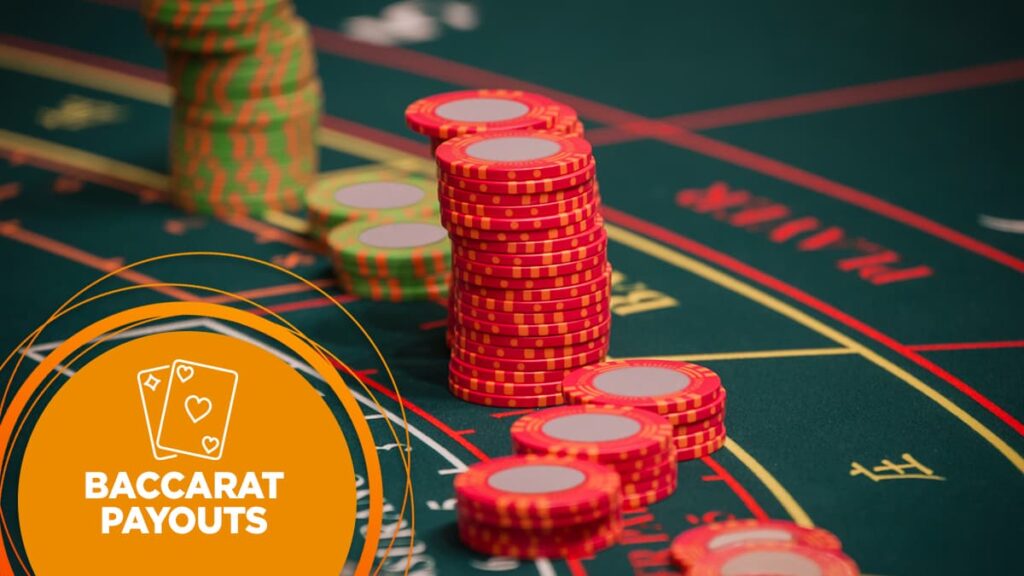Baccarat’s Dual Nature: The Dance of Low and High Volatility
Baccarat, with its reputation as a game of both elegance and simplicity, has long been a cornerstone of the casino experience. Its reputation as a low-volatility game has attracted many, but to the discerning player, there lies an opportunity to transform it into a high-volatility gamble for the house.
Delving into Baccarat Volatility and Its Implications
At its core, volatility in the realm of gambling signifies the fluctuations between wins and losses over an extended duration. A high-volatility game sporadically offers grand payouts interspersed with several losing rounds, while a low-volatility counterpart delivers regular small wins and seldom large payouts. Baccarat, with its trifecta of bets – Banker, Player, and Tie, sits comfortably as one of the lowest volatility casino games, primarily due to the Banker hand’s winning probability of 50.68% in each round, excluding ties.
By strategically deploying a smart betting strategy, players can significantly mitigate their risk while engaging in Baccarat. This approach effectively aids in gradually tipping the scales in favor of the player over time.
Two Faces of Volatility: A Player’s Guide
Volatility possesses two dimensions, often referred to as ‘The Two Sides of Volatility.’ The first side encompasses the player’s control aspect, namely, the magnitude of the bet placed, a strategy commonly referred to as bankroll management. The second side, however, is the natural fluctuation of results over time, the decisive factor that ultimately determines a player’s victory or loss.
| Baccarat Bet Type | Volatility |
|---|---|
| Banker Bet | Low |
| Player Bet | Low |
| Tie Bet | High |
Unveiling Volatility in Casino Games
To better comprehend the concept of a low-volatility game, consider a coin toss that offers even money. With only two possible outcomes, the chances of winning each round stand at 50/50. The potential wins are small, as are the losses. Conversely, a high-volatility game like a single number bet on roulette presents far more significant returns of 35:1, with a considerably lower probability of winning, which consequently incurs greater losses.
In contrast, Baccarat’s volatility is relatively low, making it an appealing choice for high rollers. Despite the small margins, the vast amounts bet per hand can convert this low volatility game into a high volatility gamble for the casinos.

The Numerical Dance: Baccarat RTP Explanation
In the world of casino games, three critical metrics come into play when a game is developed. Firstly, the Return to Player (RTP) percentage signifies the theoretical portion that players should retain. Secondly, the hold percentage marks the theoretical fraction that the casino retains. Lastly, the Confidence Level refers to the likelihood of RTP and hold percentages falling within the developer-defined parameters, typically set at a 90% confidence level.
Given the enormous sums often bet per hand by high rollers, Baccarat can become highly volatile for the casinos. There is a 95% chance that a player will land within two standard deviations of the expected outcome, which translates to a range of 75 units behind and 51 units ahead (where a unit is the betting amount). The rarity of a player’s result lying outside these parameters increases the volatility and the potential winnings for players, leading to potentially significant losses for the casino.
| Baccarat Bet Type | RTP |
|---|---|
| Banker Bet | 98.94% |
| Player Bet | 98.76% |
| Tie Bet | 85.64% |
Baccarat House Edge
The house edge indicates the average profit the casino makes from each bet. Lower house edge means the bet is more favorable to the player in the long run.
| Baccarat Bet Type | House Edge |
|---|---|
| Banker Bet | 1.06% |
| Player Bet | 1.24% |
| Tie Bet | 14.36% |
Crucial Factors Affecting Baccarat Volatility
Primarily, Baccarat’s volatility is influenced by the number of hands played and the payout size. The number of bets or rounds played directly impacts the win percentage and amount. The more rounds played, the closer the actual results align with the predicted values, resulting in an expected value and standard deviation that approach their theoretical values. Hence, high-stake players who play long sessions are more likely to experience the game’s predicted low volatility.
However, the payout size, especially with the ‘Tie’ bet, can increase Baccarat’s volatility significantly. The Tie bet, paying 8:1, introduces a higher degree of volatility into the game as its occurrence is far less predictable, and its payout significantly larger than the Banker or Player bets. Therefore, players seeking a high volatility strategy might opt to place occasional Tie bets.
Volatility: Boon or Bane?
Ultimately, whether the volatility of Baccarat is considered a boon or a bane boils down to individual player preferences and risk tolerance.
For the risk-averse player, the low-volatility aspect of Baccarat is undeniably appealing, offering a stable, predictable game with a high probability of minor wins. For such players, focusing on the Banker or Player bets and employing a conservative betting strategy can ensure an enjoyable gaming experience with minimal risk.
Conversely, the thrill-seeker might revel in Baccarat’s high volatility potential, fueled by occasional Tie bets and higher wager amounts. This strategy, although riskier, can offer higher rewards and add an exhilarating edge to the gaming experience.
Volatility in Other Casino Table Games
Certainly, the volatility principles mentioned can be applied across all casino table games, not only limited to baccarat. So, if you enjoy dabbling in games other than baccarat, such as roulette or others, understanding the volatility in those games could prove beneficial.
Roulette, particularly American Roulette, provides an interesting study in these principles. With a fixed RTP of 94.75%, statistically, you’re expected to lose over time. Yet, volatility varies across different types of bets. A straight-up bet offers the most volatility with a 35:1 payout, while a low-volatility bet could be an even-money wager, such as betting on red. Sticking to low-volatility bets means the RTP will gradually eat away your stake. However, high-volatility bets may provide an opportunity to deviate from the negative expectation and score a win.
It may come as a surprise, but blackjack, a game well-known for its minimal house edge of 0.5% when played with perfect strategy, is quite volatile. But remember, a low house edge doesn’t equate to low volatility. If played without optimal strategy, the dealer has a 5% edge in win frequency. By following basic strategy and knowing when to double down or split, this edge can be mitigated. Furthermore, many tables offer increased payouts for natural blackjack, reducing the edge.
But mitigating the edge requires taking more risks: betting more via doubling down and splitting, and playing longer for the chance of enhanced natural blackjack payouts. Essentially, players are anticipating larger wins to compensate for smaller losses, a clear demonstration of volatility.
Caribbean Stud Poker, another popular and volatile card game, may also mislead players with its high payout hands and enticing $1 side bet for a progressive jackpot, giving the impression of a game risky for the casino. Yet, a closer look at the paytable dispels this illusion. The game’s structure favors occasional large payouts, with most hands losing. Despite the appearance of being a low-volatility game, where regular losses are offset by big wins, Caribbean Stud Poker is indeed a high-volatility game.

Conclusion: Baccarat – A Game for Every Player
In conclusion, Baccarat’s seemingly contradictory nature, its ability to be both a low-volatility and high-volatility game, is part of its allure. Its flexibility allows it to accommodate both conservative and adventurous players, making it a truly versatile casino game. Like an elegant dance, the rhythm and intensity of the game can shift from round to round, offering a dynamic gaming experience that is rarely replicated in other casino games.
FAQ
-
What does volatility mean in Baccarat?
Volatility in Baccarat refers to the level of risk involved in the game. Low volatility games like Baccarat typically involve lower risks, with frequent but smaller payouts. High volatility, on the other hand, is characterized by less frequent but potentially larger wins.
-
Is Baccarat a low or high volatility game?
Baccarat can be considered both a low and high volatility game. It is inherently a low-volatility game due to its design, which favors the ‘Banker’ and ‘Player’ bets with a house edge of around 1%. However, the ‘Tie’ bet, with its 8:1 payout, introduces a higher degree of volatility.
-
What kind of players does Baccarat appeal to?
Baccarat appeals to a wide range of players. For risk-averse players, the low volatility aspect of Baccarat is appealing, offering predictable outcomes and a higher probability of minor wins. For risk-loving players, the high volatility potential, brought about by occasional ‘Tie’ bets, can offer higher rewards and a thrilling gaming experience.
-
How can I adjust my strategy based on Baccarat's volatility?
If you prefer a lower risk game, focus on the ‘Banker’ or ‘Player’ bets and employ a conservative betting strategy. If you seek a higher risk, higher reward game, consider placing occasional ‘Tie’ bets and wagering higher amounts.
-
Does the volatility of Baccarat affect its popularity?
No, Baccarat’s volatility contributes to its popularity by making it a versatile game. The ability to be both a low and high volatility game allows it to cater to different player preferences and risk tolerances, which enhances its appeal.









